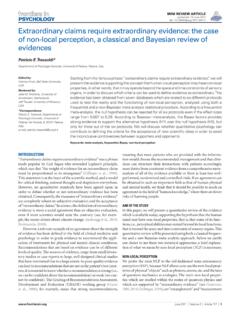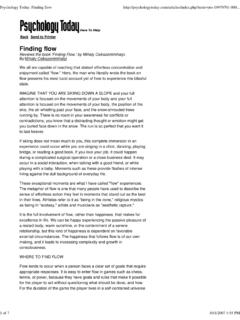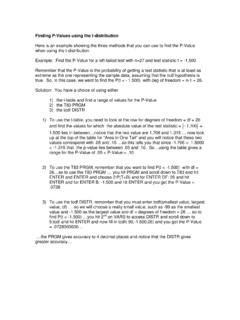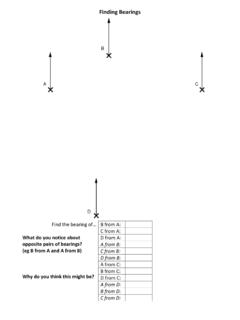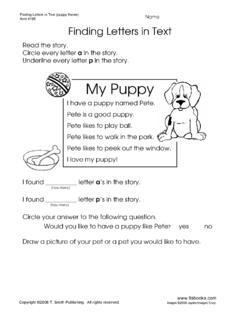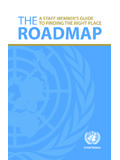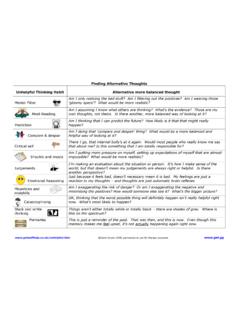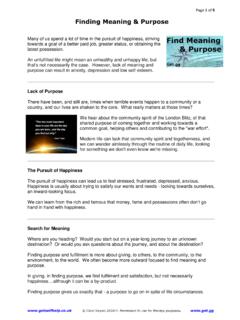Transcription of Finding and Correcting Flawed Research Literatures
1 THE HUMANISTIC PSYCHOLOGIST, 33(4), 293 303. Copyright 2005, Lawrence Erlbaum Associates, Inc. Finding and Correcting Flawed Research Literatures Edward A. Delgado-Romero Department of Educational Psychology University of Georgia George S. Howard Department of Psychology University of Notre Dame Humanistic psychology has always viewed scientific psychology with skepticism. Good reasons for this skepticism continuously appear. One is then left with the choice, Is a scientific approach to humans inherently wrongheaded? or Is scien- tific psychology an imperfect but improving enterprise? This article reviews another domain where Research in scientific psychology proves misleading.
2 Suppose a psychologist was asked a question such as, Is psychotherapy effec- tive? or Is remote intercessory prayer effective? or Do humans possess psychic powers? How might a psychologist reply? The most common strategy would be to conduct a meta-analysis over the relevant Research literature and report the results. In all 3 cases ( , psychotherapy, efficacy of remote intercessory prayer, and telepathic powers) the answer would be a significant, positive effect size, suggesting that all 3. are real, efficacious phenomena. Unfortunately, in at least 2 of the 3 cases, the litera- ture likely gives an incorrect answer to the question. How can one show that some lit- eratures yield incorrect answers to Research queries, whereas other Literatures give correct answers?
3 Finally, how should psychology's publication practices change to avoid Flawed Literatures ? For well over a century, a strain of thought in psychology has been skeptical of the scientific analysis of persons (Bakan, 1967; James, 1950). Around the mid- dle of the last century, many of the voices of protest coalesced in the humanistic Correspondence should be addressed to George Howard, Department of Psychology, University of Notre Dame, 218 Haggar Hall, Notre Dame, IN 46556. E-mail: 294 DELGADO-ROMERO AND HOWARD. psychology movement (Giorgi, 1970; Mair, 1989; Rogers, 1973; Wertz, 1992). A central tenet of humanistic psychology has been skepticism of a natural sci- ence approach to psychology, and the desire for a human science alternative (Giorgi, 1970, 1992).
4 Although the development of a human science alternative has made some progress, humanistic psychology's larger impact has come as a critique of the natural science excesses of mainstream psychological Research (Giorgi, 1970; Howard, 1982; Howard & Conway, 1986; Rogers, 1973). This ar- ticle reviews yet another glaring problem with natural science Research with hu- mans and the need for (at least) a revision of psychology's current Research prac- tices. In earlier programs of Research , my colleagues and I found flaws in mainstream Research methodologies regarding the value of retrospective pretests ( , Howard, Ralph, et al, 1979), use of behavior versus self-report measures ( , Howard, Maxwell, Wiener, Boynton, & Rooney, 1980), and the proportion of vari- ance in human behavior due to free will ( , Howard & Conway, 1986).
5 In each Research program a softer or more humanistic alternative methodology was actu- ally found that was more valid than a harder or more behavioral methodology that was favored in natural science, psychological Research . The philosophy of sci- ence behind this empirical upgrading of accepted methodologies is laid out in Howard (1982). A recent program of Research (Howard, Hill, et al, 2005; Howard, Lau, et al, 2005; Lau, Howard, Maxwell, & Venter, 2005; Sweeny & Howard, 2005) sug- gested that there are problems with several Research Literatures in psychology. These problems are caused by the discipline's preference for significant, rather than nonsignificant, findings in deciding which articles will be published and which will not.
6 This preference is often overtly stated, for example in the APA pub- lication manual (2001) and in the editorial statements made by journal editors. It does not matter whether the decision to publish good (statistically significant re- sults) or not to pursue or publish bad (nonsignificant findings ) is made by a jour- nal editor, a reviewer, or researchers themselves. It is problematic because any preference for good over bad findings leads to a biased and sometimes se- verely misleading Research literature . Imagine a baseball player who computes his batting average by only including days on which he got one or more hits (his good days) and eliminates days when he did not get any hits (his bad days).
7 Obviously, his computed batting average ( , .600) would represent a gross distortion of his real ( , when all at bats are in- cluded) batting average ( , .300). This represents an analogy to the classic file drawer (Rosenthal, 1979) problem in psychological Research . If one reclaims . one half of the player's days from the file drawer, one could correct the misleading literature ( , .600) somewhat ( , batting average goes from .600 to .450). Al- though this corrected average is a more accurate estimate than the original batting Flawed Literatures 295. average, it is still wrong ( , the Truth is .300, not .450).1 Although all attempts to correct Flawed meta-analyses yield improved estimates, unless one identifies all the studies in the file drawer (which is a virtual impossibility) the resulting esti- mate is better, but still incorrect.
8 A METHOD FOR Finding Flawed Literatures . A NEW MOUSETRAP. Suppose one wanted to determine the extent to which the literature suggesting the effectiveness of psychotherapy is biased by the file drawer effect. The literature (Lambert & Bergin, 1994) suggests that the average treatment subject would be at the 80th percentile (instead of the 50th percentile) of a comparable control group at posttest. One way to test the validity of the psychotherapy effectiveness literature is to begin forming a new literature where there is no possibility of a file drawer ef- fect. To do so, one must conduct several studies and accept all results (regardless of whether or not they reached statistical significance) that are obtained by method- ologically adequate studies.
9 Imagine there are two different possibilities: the present literature is exactly cor- rect ( , the average treatment subject percentile across new studies is .80, as Smith, Glass, and Miller, 1980 reported) or; the present literature is based solely on Type I. errors ( , the average treatment percentile is .50, which would occur when the treatment and control groups means are identical). That is, imagine 100 studies were conducted and only 4 of them obtained significant findings . Further, the truth (if all 100 studies were published) is that treatment is not effective. However, if the litera- ture consisted of only the four significant effects, which were the only studies pub- lished, then the literature would be based only on the four published Type I errors.
10 Now imagine that one conducted four studies (with a sample size of each study close to the average for the literature in question) and the treatment subjects' per- centiles were .74, 62, .89, and .77. The average percentile of .76 looks very close to the literature 's value of .80. Thus, one would tentatively conclude that the literature appears to be contaminated very little (or not at all) by the file drawer effect. This is because, if the null were true ( , 50th percentile), it is extremely unlikely that four independent studies would achieve results of .74, .62, .89, and .79. Still, our 1 Meta-analysts have developed a number of adjustment methods in an effort to eliminate the effect of publication bias on estimating the true effect size ( , Duvall & Tweedie, 2000; Hedges & Vevea, 1996; Iyengar & Greenhouse, 1988).
